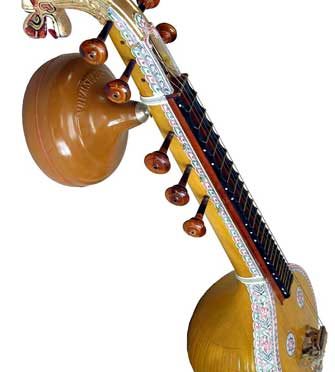The veena or vina is a large plucked lute that originated in the Indian subcontinent. The veena has a long history and has evolved into various regional designs, each with its own unique name, such as the Rudra veena, Saraswati veena, and Vichitra veena.
Notably, the veena is considered one of the oldest Indian instruments and is mentioned in ancient texts such as the Rigveda and Samaveda, dating back to the first millennium BCE. The original Sanskrit word “veena” refers to any plucked stringed instrument, but in some ancient texts, the modern veena is credited to Narada (a Vedic sage, a traveling musician and storyteller), who is depicted playing it.
Early versions of the veena varied in size, number of strings, and playing technique. The version with seven strings and 24 frets became standard between the 10th and 11th centuries CE. Further innovations and modifications to the veena were developed in the 17th century during the reign of Raghunath Nayak in Thanjavur, Tamil Nadu.
The differences between the North and South Indian veena architecture lie in the existence of twin sonorous gourds in the North, whereas in the South, a pear-shaped wooden body is affixed in place of the lower gourd. Contemporary designs employ fiberglass or alternative materials instead of carved jackwood and gourds.
There are several types of veena, each with its own characteristics and playing techniques. Some notable types include:
Saraswati Veena: This is a fretted veena and is highly revered. It is associated with the goddess Saraswati and is often depicted being played by her. The Saraswati veena is considered the queen of all musical instruments in the southern region of India.
Rudra Veena: The Rudra veena is a larger and more ancient version of the veena. It is associated with the Dhrupad style of Indian classical music and is known for its deep and resonant sound. More about the Rudra veena.

Vichitra Veena: The Vichitra veena is unique in that it does not have any frets and is played with a slide. It is known for its ability to produce intricate melodies and is typically used in the Hindustani classical music tradition. More about the Vichitra veena.

The veena holds a significant place in Indian classical music and is considered the national musical instrument of India. It is revered in Indian culture and is frequently associated with the goddess Saraswati, who is the patroness of music, arts, and learning.
The veena has had a profound influence on Indian music, both instrumental and vocal. It is known for its ability to demonstrate different gamakas (ornamentation) and has influenced the style of vocal music as well.
(headline image: Saraswati veena)


